| Author | Message |
Vox HDC-77 PRINCES LAST OFF THE SHELF GUITAR Vox VH-HDC77 (For Sale £1799.99) Email me: info@hertfordshirecomputerservices.comThe Vox HDC 77 was Princes last guitar he used during his 3rd eye girl tour and album, he owned a few, a custom wrapped HDC 77 and a black burst version. I have a beautiful amber burst example in mint condition with its original case and instructions, it is spotless and has an amazing finish. This is possibly the last remaining example of this ultra rare guitar and has an amazing variation of sounds, I have included a more detailed description below.
Vox VH-HDC77
Vox VH-HDC77
Vox VH-HDC77Prince
One of Princes VOX HDC-77 guitars features a colourful psychedelic pattern chosen by #Prince. He played it frequently during his '70s funk-rock inspired #3RDEYEGIRL era, complementing the design of the guitar with custom made swirly and psychedelic tunics. Although it looks hand-painted, this design was actually turned into a sticker that was laid across the body of the guitar at Prince's request. Notable performances with this VOX include the historic debut television performance with 3RDEYEGIRL on Late Nite With Jimmy Fallon in 2013, his Arsenio Hall Show take-over in 2014, and numerous live performances throughout the 2013 #LiveOutLoud and 2014 #HITNRUN Part 2 tours. Check out more #PrinceHistory in these links: Consequence of Sound - Prince takes over Arsenio, performs three songs, reveals his love for omelets NME - Prince plays secret ‘open soundcheck’ show in London’s Electric Ballroom
n 2012 Prince started appearing with a new main guitar – the Vox HDC-77. This was momentous, and somewhat bewildering for fans. Why was Prince not playing his Hohner Madcat, or a Stratocaster, or even a new Cloud? Vox are most famous for their amps. Their AC30 amplifiers typified the “British invasion” sound of the 60s, and were used by The Beatles, the Rolling Stones, and the Kinks amongst many others. But Vox have also been making iconic guitars since the 60s, the most recognisable being the Phantom with its irregular pentagonal shape, and the Teardrop. According to André Cymone, he owned a Phantom V as a youngster, and Prince borrowed it – André believes that the Phantom was the first electric guitar Prince played. You can hear more in the Touré Show podcast from June 2018
In 1992 Vox was purchased by Korg, and they have continued to produce guitars intermittently, usually focussing on innovating design and (sometimes crazy) electronics.
There were two different variants that Prince played in concert. The HDC-777 Blackburst appears to be an unmodified stock model. There was also an Ivory/White version with a custom tie-dye design on the curved top – more about that another time. For Prince guitar nerds like me, today was a good day…the question about how Prince came to own the Vox was answered by Ida Nielsen, NPG and 3RDEYEGIRL bass player. Responding to one of my posts on Twitter, Ida says that it was her that first introduced Prince to the Vox. “I bought one for me and then he liked it so much that I got one for him too”.
Photos from Paisley Park taken on the 21st April 2016 illustrate that Prince kept his Vox close to him – there was one in his office. Although he had said that he couldn’t play guitar while he was focussing on his Piano & A Microphone tour, it still appears to have been his guitar of choice. The last evidence I can find of Prince playing the black Vox are the photos of his performance for Barack Obama at the White House in June 2015, and he performed with the ivory Vox on the 1st January 2016 at a private New Year’s Eve party. If you know differently please do let me know. To date there has been no sign of the Black Vox guitar on display at Paisley Park or on the My Name Is Prince tour. I can only presume that it remains archived in the Paisley Park instrument room. The more recognisable tie-dyed ivory model has been on display in the atrium at Paisley Park and in the exhibitions in London and Amsterdam. For those looking to own an HDC-77, they now tend to command a higher price than when they were first made. Blackburst models are especially hard to find, I’ve seen three for sale since 2016, all of them were sold almost immediately. Be prepared to pay upwards of £1000. Good luck finding one! Share this:The legacy of Vox-branded electric guitars goes all the way back to the early sixties, and arguably the most famous models of all can thank their legendary users for their notoriety. The Stones' Brian Jones used the classic Teardrop Mark VI, while Joy Division singer Ian Curtis strummed a Phantom VI - two designs that were reissued in 1998.
These two models bear little resemblance to those of the past and instead include a selection of innovative features that should fascinate as well as impress. Although many of them are also included on the flagship Virage range, as well as the more modestly-priced Series 33 models, it's hoped that the models within the 77 and 55 series will mix the best modern guitar design with retail prices that won't cause anyone to turn away in disgust. Currently the Series 77 includes just the double-cutaway design that we have on review here, but the Series 55 includes both double and single-cut designs. Rich Lasner is vice president of development at Vox Guitars and during his time at Ibanez Hoshino was, among many other things, integral in the development of Steve Vai's JEM. Lasner's crack team also includes chief designer Eric Kirkland and senior production engineer Bob McDonald. The 77 is a true semi-acoustic that, internally at least, sits between the designs of a Gibson ES-335 and a Gretsch 6120 in that it features neither a full-length central block nor a perfectly hollow body. The top and back are fashioned from two separate three-layer laminates of maple, with a nicely flamed grade of maple on the outer facing. Then we have a solid mahogany centre: the outer sides and what Vox calls Tone Bars, which run from the heel, underneath the pickups, to the bridge posts. "The HDC-77 is a combination of traditional laminated semi-hollow construction and our 3-D body contouring," explains Kirkland. "The top and back are pressed into shape on steel plates, which are then glued to the guitar's centre rim section that's cut out of solid wood." What's more, the 77 features an extreme amount of body shaping and sculpting. Not only are the top and rear arched, but the body as a whole drops away from the straight plane of the fingerboard and strings and, in effect, curves around your own body as you play it. It's called 3-D Body Contouring, and for good reason - the 77 provides a particularly intimate playing experience, as we've found with all these new Vox guitars. This contouring really comes into its own when played standing, as the act of pressing the guitar body into your own torso with your forearm puts the mahogany neck exactly where it needs to be. The heel, which is also part of the internal mahogany rim of the guitar, is designed with both player comfort and tone in mind - it's possible to access all 22 frets without the thumb of your fretting hand coming into contact with the body at all. "The advantage of our neck joint is that the body extends beyond where it would typically go and forms the heel of the neck, which lets us maximize the surface area of the joint to better transfer string energy," says Kirkland. "We like to think it looks cool as well!" All modern Vox electrics feature the company's own design CoAxe pickups. Neither a single-coil nor humbucker in the traditional sense, the design incorporates a central row of pole-pieces encased in a high-impedance coil that's flanked by two blades. The entire construction is then surrounded by a low-impedance winding, which cancels the hum. "The basic idea is that the coils are coaxial: they're on the same plane, not stacked," Kirkland tells us. "The advantage is that the centre sensing coil can work like a true single-coil and the outer, noise-cancelling coil is outside the magnetic field, between the central poles and the blades. "Being outside the field allows the noise-cancelling coil to have relatively low impedance, so it doesn't take any of the sparkle away in the clean or crunch modes. Both the centre sensing coil and the outer noise-cancelling coil are tapped, so we can offer a good range of noise-free tone." The modes Kirkland mentions refer to the three options that are available for each pickup: clean, crunch and dirty. These can also be described as single-coil, P-90 and humbucker. The guitar's electrics therefore comprise a standard three-way toggle for pickup selection, plus two additional three-way switches that allow for the independent selection of the three modes for each pickup. Even the bridge is a new design, intended to increase the intimacy of the join between metal and wood. It's an all-in-one system that sees an aluminium bridge and tailpiece fixed to the body via a pair of steel posts that can be easily raised or lowered with a simple hex wrench. "The MaxConnect bridge enhances tone by improving the mechanical coupling of the bridge and the bridge posts," reckons Kirkland. "Typically, a bridge mounted to these kind of posts uses small screws to adjust its position on the posts for intonation. We extended the saddle adjustment range to make these screws unnecessary, so that the string tension pulls the bridge tight against the posts. "The base is made of cast aluminium and, once we hit on the basic idea of in essence 'unfolding' a wraparound bridge, the design evolved easily." Sounds
We should state at the outset that such is the efficiency of the guitar's semi-acoustic nature, it can sometimes be difficult to perceive the changes in tone when selecting different modes. With a reasonably hot rock tone from the Orange TH30, the bridge pickup's humbucker tone is huge, with a real Billy Gibbons-style level of articulation. Using the same settings with the neck humbucker, the musical sustain is almost limitless and provides enough upper middle to avoid mushing up. Cleaning the neck's HB mode up on the amp gives a more than usable tone for jazz as long as you round proceedings off further with the guitar's tone control, and the P-90 mode, with a push of amp drive, is lovely for lilting blues and half-chords. Advertisement
The single-coil mode further reduces the mids, although without giving much in the way of a suitably Fendery twang, and combinations of the bridge pickup in that mode with the P-90 of the neck give full chords an unusual yet ear-catching character. The 77 double cutaway has plenty of lower end, with a slightly less defined midsection and a sweet treble response. In any number of applications - from perfectly clean to all-out rock - it's very musically rounded, not brash. We've not yet seen the flagship Virage II guitars, but Kirkland reckons, "the 77 is a bit more aggressive in looks and sound - and price! We think it might appeal to a 'modern rock' sort of player." And there's no doubt in our minds that the 77 does modern rock very well indeed. But we feel the guitar's tonal strengths lie with more subtle styles: there's warmth and versatility here if you need it. The 77 will appeal to anyone after a genuinely unique twist on the thinline semi theme.
| |
- E-mail - orgNote -  Report post to moderator Report post to moderator |
Looking at the images, isn't it amazing with how much care to detail Prince watched over his overall appearance - I mean, dress and guitar and make-up matching, ain't that something | |
- E-mail - orgNote -  Report post to moderator Report post to moderator |
 New topic
New topic Printable
Printable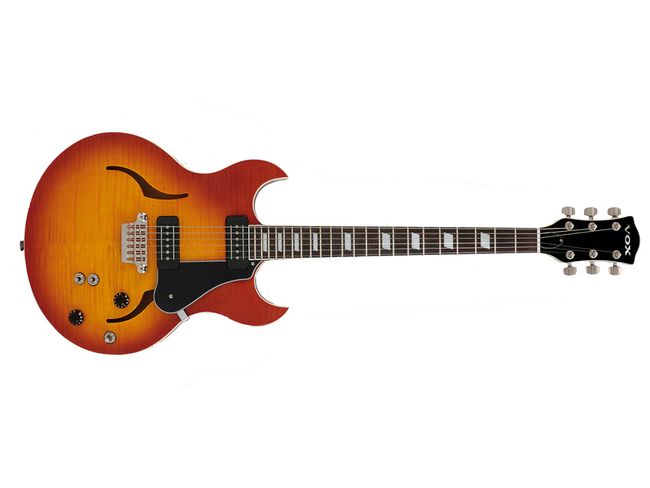
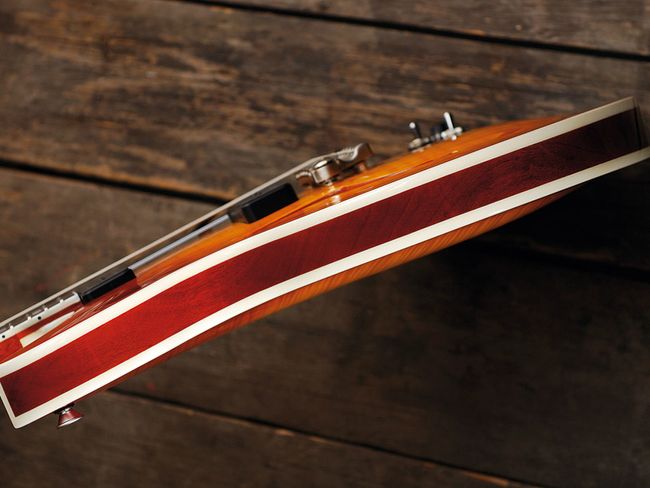
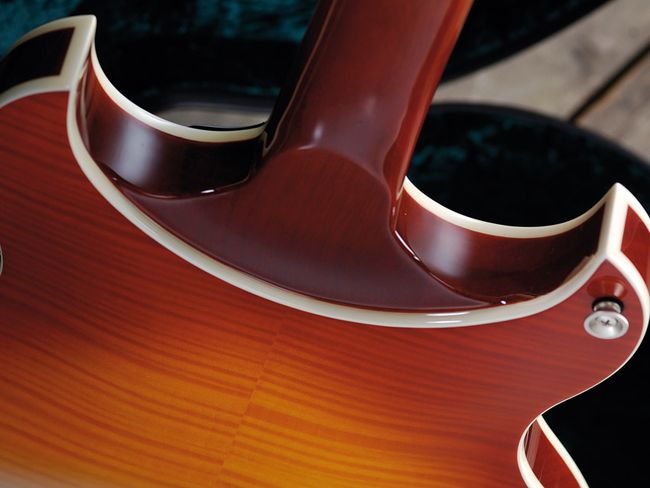

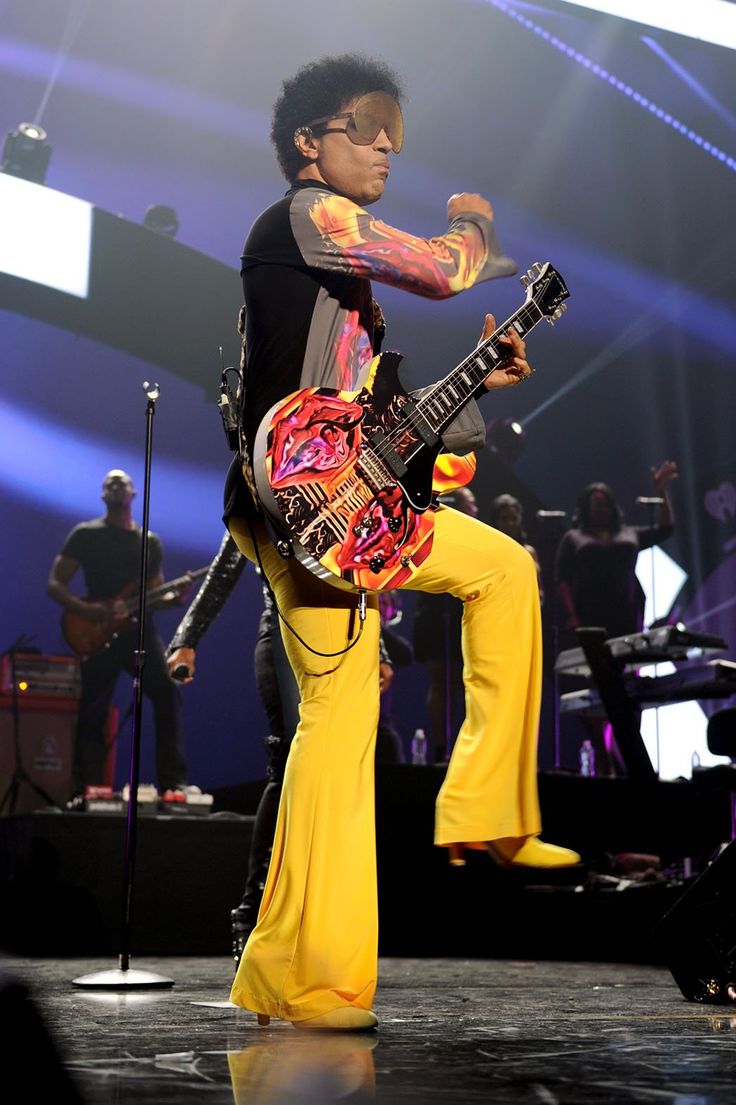
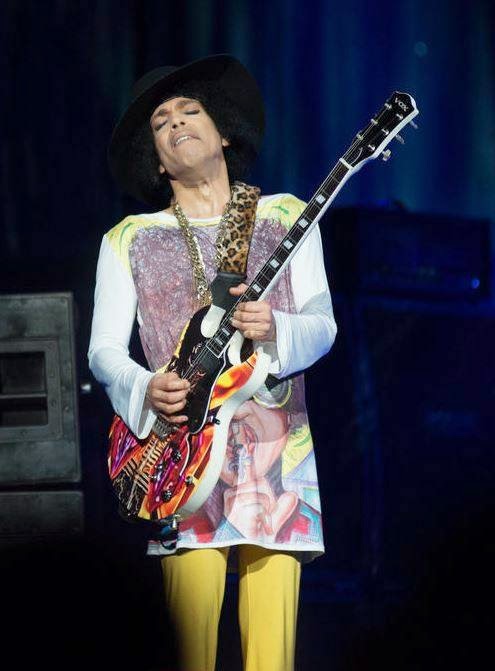

 Prince performing with his Vox HDC-77 Blackburst
Prince performing with his Vox HDC-77 Blackburst

